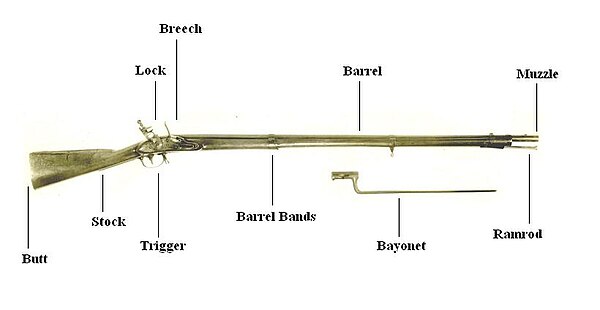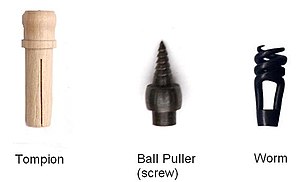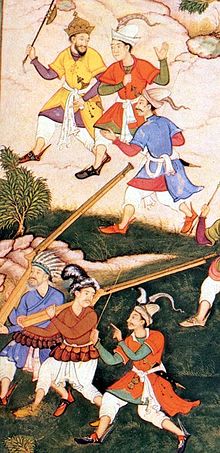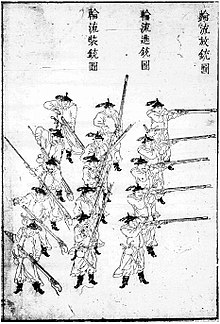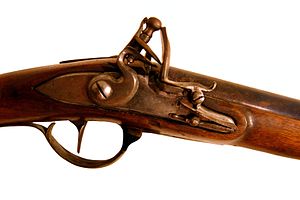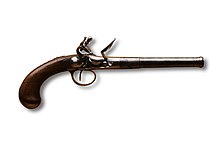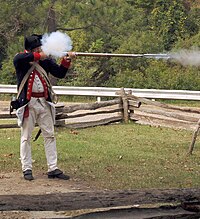
Early uses of this term
The first use of the term "weapon of mass destruction" on record is by Cosmo Gordon Lang, Archbishop of Canterbury, in 1937 in reference to the aerial bombing of Guernica, Spain:
Who can think at this present time without a sickening of the heart of the appalling slaughter, the suffering, the manifold misery brought by war to Spain and to China? Who can think without horror of what another widespread war would mean, waged as it would be with all the new weapons of mass destruction?
At the time, nuclear weapons had not been developed. Japan conducted research on biological weapons , and chemical weapons had seen wide battlefield use in World War I. Their use was outlawed by the Geneva Protocol of 1925. Italy used mustard agent against civilians and soldiers in Ethiopia in 1935–36.
Following the atomic bombings of Hiroshima and Nagasaki that ended World War II and during the Cold War, the term came to refer more to non-conventional weapons. The application of the term to specifically nuclear and radiological weapons is traced by William Safire to the Russian phrase "Оружие массового поражения" – oruzhiye massovogo porazheniya (weapon of mass destruction).
William Safire credits James Goodby (of the Brookings Institution) with tracing what he considers the earliest known English-language use soon after the nuclear bombing of Hiroshima and Nagasaki (although it is not quite verbatim): a communique from a 15 November 1945, meeting of Harry Truman, Clement Attlee and Mackenzie King (probably drafted by Vannevar Bush, as Bush claimed in 1970) referred to "weapons adaptable to mass destruction."
Safire says Bernard Baruch used that exact phrase in 1946 (in a speech at the United Nations probably written by Herbert Bayard Swope). The phrase found its way into the very first resolution the United Nations General assembly adopted in January 1946 in London, which used the wording "the elimination from national armaments of atomic weapons and of all other weapons adaptable to mass destruction." The resolution also created the Atomic Energy Commission (predecessor of the International Atomic Energy Agency (IAEA)).
An exact use of this term was given in a lecture titled "Atomic Energy as a Contemporary Problem" by J. Robert Oppenheimer. He delivered the lecture to the Foreign Service and the State Department, on 17 September 1947.
It is a very far reaching control which would eliminate the rivalry between nations in this field, which would prevent the surreptitious arming of one nation against another, which would provide some cushion of time before atomic attack, and presumably therefore before any attack with weapons of mass destruction, and which would go a long way toward removing atomic energy at least as a source of conflict between the powers.
The term was also used in the introduction to the hugely influential U.S. government document known as NSC 68 written in 1950.
During a speech at Rice University on 12 September 1962, President John F. Kennedy spoke of not filling space "with weapons of mass destruction, but with instruments of knowledge and understanding." The following month, during a televised presentation about the Cuban Missile Crisis on 22 October 1962, Kennedy made reference to "offensive weapons of sudden mass destruction."
An early use of the exact phrase in an international treaty is in the Outer Space Treaty of 1967, but the treaty provides no definition of the phrase, and the treaty also categorically prohibits the stationing of "weapons" and the testing of "any type of weapon" in outer space, in addition to its specific prohibition against placing in orbit, or installing on celestial bodies, "any objects carrying nuclear weapons or any other kinds of weapons of mass destruction."
Evolution of its use
During the Cold War, the term "weapons of mass destruction" was primarily a reference to nuclear weapons. At the time, in the West the euphemism "strategic weapons" was used to refer to the American nuclear arsenal. However, there is no precise definition of the "strategic" category, neither considering range nor yield of the nuclear weapon.
Subsequent to Operation Opera, the destruction of a pre-operational nuclear reactor inside Iraq by the Israeli Air Force in 1981, the Israeli prime minister, Menachem Begin, countered criticism by saying that "on no account shall we permit an enemy to develop weapons of mass destruction against the people of Israel." This policy of pre-emptive action against real or perceived weapons of mass destruction became known as the Begin Doctrine.
The term "weapons of mass destruction" continued to see periodic use, usually in the context of nuclear arms control; Ronald Reagan used it during the 1986 Reykjavík Summit, when referring to the 1967 Outer Space Treaty. Reagan's successor, George H. W. Bush, used the term in a 1989 speech to the United Nations, primarily in reference to chemical arms.
The end of the Cold War reduced U.S. reliance on nuclear weapons as a deterrent, causing it to shift its focus to disarmament. With the 1990 invasion of Kuwait and 1991 Gulf War, Iraq's nuclear, biological, and chemical weapons programs became a particular concern of the first Bush Administration. Following the war, Bill Clinton and other western politicians and media continued to use the term, usually in reference to ongoing attempts to dismantle Iraq's weapons programs.

After the 11 September 2001 attacks and the 2001 anthrax attacks in the United States, an increased fear of nonconventional weapons and asymmetric warfare took hold in many countries. The fear reached a crescendo with the 2002 Iraq disarmament crisis and the alleged existence of weapons of mass destruction in Iraq that became the primary justification for the 2003 invasion of Iraq; however, American forces found none in Iraq. They found old stockpiles of chemical munitions including sarin and mustard agents, but all were considered to be unusable because of corrosion or degradation. Iraq, however, declared a chemical weapons stockpile in 2009 which U.N. personnel had secured after the 1991 Gulf War. The stockpile contained mainly chemical precursors, but some munitions remained usable.
Because of its prolific use and (worldwide) public profile during this period, the American Dialect Society voted "weapons of mass destruction" (and its abbreviation, "WMD") the word of the year in 2002, and in 2003 Lake Superior State University added WMD to its list of terms banished for "Mis-use, Over-use and General Uselessness" (and "as a card that trumps all forms of aggression").
In its criminal complaint against the main suspect of the Boston Marathon bombing of 15 April 2013, the FBI refers to a pressure-cooker improvised bomb as a "weapon of mass destruction."
There have been calls to classify at least some classes of cyber weapons as WMD, in particular those aimed to bring about large-scale (physical) destruction, such as by targeting critical infrastructure. However, some scholars have objected to classifying cyber weapons as WMD on the grounds that they "cannot [currently] directly injure or kill human beings as efficiently as guns or bombs" or clearly "meet the legal and historical definitions" of WMD.
Definitions of the term
United States
Strategic definition
The most widely used definition of "weapons of mass destruction" is that of nuclear, biological, or chemical weapons (NBC) although there is no treaty or customary international law that contains an authoritative definition. Instead, international law has been used with respect to the specific categories of weapons within WMD, and not to WMD as a whole. While nuclear, chemical and biological weapons are regarded as the three major types of WMDs, some analysts have argued that radiological materials as well as missile technology and delivery systems such as aircraft and ballistic missiles could be labeled as WMDs as well.
However, there is an argument that nuclear and biological weapons do not belong in the same category as chemical and "dirty bomb" radiological weapons, which have limited destructive potential (and close to none, as far as property is concerned), whereas nuclear and biological weapons have the unique ability to kill large numbers of people with very small amounts of material, and thus could be said to belong in a class by themselves.
The NBC definition has also been used in official U.S. documents, by the U.S. President, the U.S. Central Intelligence Agency, the U.S. Department of Defense, and the U.S. Government Accountability Office.
Other documents expand the definition of WMD to also include radiological or conventional weapons. The U.S. military refers to WMD as:
Chemical, biological, radiological, or nuclear weapons capable of a high order of destruction or causing mass casualties and exclude the means of transporting or propelling the weapon where such means is a separable and divisible part from the weapon. Also called WMD.
This may also refer to nuclear ICBMs (intercontinental ballistic missiles).

The significance of the words separable and divisible part of the weapon is that missiles such as the Pershing II and the SCUD are considered weapons of mass destruction, while aircraft capable of carrying bombloads are not.
In 2004, the United Kingdom's Butler Review recognized the "considerable and long-standing academic debate about the proper interpretation of the phrase 'weapons of mass destruction'". The committee set out to avoid the general term but when using it, employed the definition of United Nations Security Council Resolution 687, which defined the systems which Iraq was required to abandon:
- "Nuclear weapons or nuclear-weapons-usable material or any sub-systems or components or any research, development, support or manufacturing facilities relating to [nuclear weapons].
- Chemical and biological weapons and all stocks of agents and all related subsystems and components and all research, development, support and manufacturing facilities.
- Ballistic missiles with a range greater than 150 kilometres and related major parts, and repair and production facilities."
Chemical weapons expert Gert G. Harigel considers only nuclear weapons true weapons of mass destruction, because "only nuclear weapons are completely indiscriminate by their explosive power, heat radiation and radioactivity, and only they should therefore be called a weapon of mass destruction". He prefers to call chemical and biological weapons "weapons of terror" when aimed against civilians and "weapons of intimidation" for soldiers.
Testimony of one such soldier expresses the same viewpoint. For a period of several months in the winter of 2002–2003, U.S. Deputy Secretary of Defense Paul Wolfowitz frequently used the term "weapons of mass terror", apparently also recognizing the distinction between the psychological and the physical effects of many things currently falling into the WMD category.
Gustavo Bell Lemus, the Vice President of Colombia, at 9 July 2001 United Nations Conference on the Illicit Trade in Small Arms and Light Weapons in All Its Aspects, quoted the Millennium Report of the UN Secretary-General to the General Assembly, in which Kofi Annan said that small arms could be described as WMD because the fatalities they cause "dwarf that of all other weapons systems – and in most years greatly exceed the toll of the atomic bombs that devastated Hiroshima and Nagasaki".
An additional condition often implicitly applied to WMD is that the use of the weapons must be strategic. In other words, they would be designed to "have consequences far outweighing the size and effectiveness of the weapons themselves". The strategic nature of WMD also defines their function in the military doctrine of total war as targeting the means a country would use to support and supply its war effort, specifically its population, industry, and natural resources.
Within U.S. civil defense organizations, the category is now Chemical, Biological, Radiological, Nuclear, and Explosive (CBRNE), which defines WMD as:
(1) Any explosive, incendiary, poison gas, bomb, grenade, or rocket having a propellant charge of more than four ounces [113 g], missile having an explosive or incendiary charge of more than one-quarter ounce [7 g], or mine or device similar to the above. (2) Poison gas. (3) Any weapon involving a disease organism. (4) Any weapon that is designed to release radiation at a level dangerous to human life.
Military definition
For the general purposes of national defense, the U.S. Code defines a weapon of mass destruction as:
- any weapon or device that is intended, or has the capability, to
cause death or serious bodily injury to a significant number of people
through the release, dissemination, or impact of:
- toxic or poisonous chemicals or their precursors
- a disease organism
- radiation or radioactivity
For the purposes of the prevention of weapons proliferation, the U.S. Code defines weapons of mass destruction as "chemical, biological, and nuclear weapons, and chemical, biological, and nuclear materials used in the manufacture of such weapons".
Criminal (civilian) definition
For the purposes of U.S. criminal law concerning terrorism, weapons of mass destruction are defined as:
- any "destructive device" defined as any explosive, incendiary, or poison gas – bomb, grenade, rocket having a propellant charge of more than four ounces, missile having an explosive or incendiary charge of more than one-quarter ounce, mine, or device similar to any of the devices described in the preceding clauses
- any weapon that is designed or intended to cause death or serious bodily injury through the release, dissemination, or impact of toxic or poisonous chemicals, or their precursors
- any weapon involving a biological agent, toxin, or vector
- any weapon that is designed to release radiation or radioactivity at a level dangerous to human life
The Federal Bureau of Investigation's definition is similar to that presented above from the terrorism statute:
- any "destructive device" as defined in Title 18 USC Section 921: any explosive, incendiary, or poison gas – bomb, grenade, rocket having a propellant charge of more than four ounces, missile having an explosive or incendiary charge of more than one-quarter ounce, mine, or device similar to any of the devices described in the preceding clauses
- any weapon designed or intended to cause death or serious bodily injury through the release, dissemination, or impact of toxic or poisonous chemicals or their precursors
- any weapon involving a disease organism
- any weapon designed to release radiation or radioactivity at a level dangerous to human life
- any device or weapon designed or intended to cause death or serious bodily injury by causing a malfunction of or destruction of an aircraft or other vehicle that carries humans or of an aircraft or other vehicle whose malfunction or destruction may cause said aircraft or other vehicle to cause death or serious bodily injury to humans who may be within range of the vector in its course of travel or the travel of its debris.
Indictments and convictions for possession and use of WMD such as truck bombs, pipe bombs, shoe bombs, and cactus needles coated with a biological toxin have been obtained under 18 USC 2332a.
As defined by 18 USC §2332 (a), a Weapon of Mass Destruction is:
- (A) any destructive device as defined in section 921 of the title;
- (B) any weapon that is designed or intended to cause death or serious bodily injury through the release, dissemination, or impact of toxic or poisonous chemicals, or their precursors;
- (C) any weapon involving a biological agent, toxin, or vector (as those terms are defined in section 178 of this title); or
- (D) any weapon that is designed to release radiation or radioactivity at a level dangerous to human life;
Under the same statute, conspiring, attempting, threatening, or using a Weapon of Mass Destruction may be imprisoned for any term of years or for life, and if resulting in death, be punishable by death or by imprisonment for any terms of years or for life. They can also be asked to pay a maximum fine of $250,000.
The Washington Post reported on 30 March 2006: "Jurors asked the judge in the death penalty trial of Zacarias Moussaoui today to define the term 'weapons of mass destruction' and were told it includes airplanes used as missiles". Moussaoui was indicted and tried for conspiracy to both destroy aircraft and use weapons of mass destruction, among others.
The surviving Boston Marathon bombing perpetrator, Dzhokhar Tsarnaev, was charged in June 2013 with the federal offense of "use of a weapon of mass destruction" after he and his brother Tamerlan Tsarnaev allegedly placed crude shrapnel bombs, made from pressure cookers packed with ball bearings and nails, near the finish line of the Boston Marathon. He was convicted in April 2015. The bombing resulted in three deaths and at least 264 injuries.
International law
The development and use of WMD is governed by several international conventions and treaties.
| Treaty | Date signed | Date of entry into force | Number of states parties | Objective |
|---|---|---|---|---|
| Geneva Protocol | 17 June 1925 | 8 February 1928 | 145 | Ban the use of chemical and biological weapons in international armed conflicts |
| Partial Nuclear Test Ban Treaty | 5 August 1963 | 10 October 1963 | 126 (list) | Ban all nuclear weapons tests except for those conducted underground |
| Outer Space Treaty | 27 January 1967 | 10 October 1967 | 111 | Ban stationing of WMD in space |
| Nuclear Non-Proliferation Treaty (NPT) | 1 July 1968 | 5 March 1970 | 190 (list) | 1. prevent nuclear proliferation; 2. promote nuclear disarmament; 3. promote peaceful uses of nuclear energy |
| Seabed Arms Control Treaty | 11 February 1971 | 18 May 1972 | 94 | Ban stationing of WMD on the ocean floor |
| Comprehensive Nuclear-Test-Ban Treaty (CTBT) | 10 September 1996 | Not in force | 176 (list) | Ban all nuclear weapons tests |
| Biological and Toxin Weapons Convention (BWC) | 10 April 1972 | 26 March 1975 | 184 (list) | Comprehensively ban biological weapons |
| Chemical Weapons Convention (CWC) | 3 September 1992 | 29 April 1997 | 193 (list) | Comprehensively ban chemical weapons |
| Treaty on the Prohibition of Nuclear Weapons (TPNW) | 20 September 2017 | 22 January 2021 | 68 (list) | Comprehensively ban nuclear weapons |
Use, possession, and access
Nuclear weapons
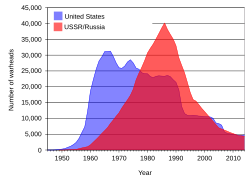
The only country to have used a nuclear weapon in war is the United States, which dropped two atomic bombs on the Japanese cities of Hiroshima and Nagasaki during World War II.
There are eight countries that have declared they possess nuclear weapons and are known to have tested a nuclear weapon, only five of which are members of the NPT. The eight are China, France, India, North Korea, Pakistan, Russia, the United Kingdom, and the United States. Israel is considered by most analysts to have nuclear weapons numbering in the low hundreds as well, but maintains an official policy of nuclear ambiguity, neither denying nor confirming its nuclear status.
South Africa developed a small nuclear arsenal in the 1980s but disassembled them in the early 1990s, making it the only country to have fully given up an independently developed nuclear weapons arsenal. Belarus, Kazakhstan, and Ukraine inherited stockpiles of nuclear arms following the break-up of the Soviet Union, but relinquished them to the Russian Federation.
Countries where nuclear weapons are deployed through nuclear sharing agreements include Belgium, Germany, Italy, the Netherlands, and Turkey.
Biological weapons

The history of biological warfare goes back at least to the Mongol siege of Caffa in 1346 and possibly much farther back to antiquity. It is believed that the Ancient Greeks contaminated their adversaries' wells by placing animal corpses in them. However, only by the turn of the 20th century did advances in microbiology allow for the large-scale weaponization of pathogens. During First World War, German military attempted to introduce anthrax into Allied livestock. In Second World War, Japan conducted aerial attacks on China using fleas carrying the bubonic plague. During the 20th century, at least nine states have operated offensive biological weapons programs, including Canada (1946–1956), France (1921–1972), Iraq (1985–1990s), Japan (1930s–1945), Rhodesia, South Africa (1981–1993), the Soviet Union (1920s–1992), the United Kingdom (1934–1956), and the United States (1943–1969).
The Japanese biological weapons program, which was run by the secret Imperial Japanese Army Unit 731 during the Sino-Japanese War (1937–1945), became infamous for conducting often fatal human experiments on prisoners and producing biological weapons for combat use. The Soviet Union covertly operated the world's largest, longest, and most sophisticated biological weapons program, in violation of its obligations under international law.
International restrictions on biological warfare began with the 1925 Geneva Protocol, which prohibits the use but not the possession or development of biological and chemical weapons. Upon ratification of the Geneva Protocol, several countries made reservations regarding its applicability and use in retaliation. Due to these reservations, it was in practice a "no-first-use" agreement only. The 1972 Biological Weapons Convention (BWC) supplements the Geneva Protocol by prohibiting the development, production, acquisition, transfer, stockpiling, and use of biological weapons. Having entered into force on 26 March 1975, the BWC was the first multilateral disarmament treaty to ban the production of an entire category of weapons of mass destruction. As of March 2021, 183 states have become party to the treaty.
Chemical weapons
Chemical weapons have been used around the world by various civilizations since ancient times. In the industrial era, they were used extensively by both sides during World War I, and by the Axis powers during World War II (both in battle and in extermination camp gas chambers) though Allied powers also stockpiled them. Countries in Western Europe renounced the use of such weapons. As of 2018, a handful of countries have known inventories, and many are in the process of being safely destroyed under the Chemical Weapons Convention. Nonetheless, proliferation and use in war zones remains an active concern, most recently the use of chemical weapons in the Syrian Civil War.
| Nation | CW Possession | Signed CWC | Ratified CWC |
|---|---|---|---|
| Albania | Eliminated, 2007 | January 14, 1993 | May 11, 1994 |
| China | Probable | January 13, 1993 | April 4, 1997 |
| Egypt | Probable | No | No |
| India | Eliminated, 2009 | January 14, 1993 | September 3, 1996 |
| Iran | Possible | January 13, 1993 | November 3, 1997 |
| Iraq | Eliminated, 2018 | January 13, 2009 | February 12, 2009 |
| Israel | Probable | January 13, 1993 | No |
| Japan | Probable | January 13, 1993 | September 15, 1995 |
| Libya | Eliminated, 2014 | No | January 6, 2004 (acceded) |
| Myanmar (Burma) | Possible | January 14, 1993 | July 8, 2015 |
| North Korea | Known | No | No |
| Pakistan | Probable | January 13, 1993 | November 27, 1997 |
| Russia | Eliminated, 2017 | January 13, 1993 | November 5, 1997 |
| Serbia and Montenegro |
Probable | No | April 20, 2000 (acceded) |
| Sudan | Possible | No | May 24, 1999 (acceded) |
| Syria | Known | No | September 14, 2013 (acceded) |
| Taiwan | Possible | n/a | n/a |
| United States | Eliminated, 2023 | January 13, 1993 | April 25, 1997 |
| Vietnam | Possible | January 13, 1993 | September 30, 1998 |
Ethics and international legal status
Some commentators classify some or all the uses of nuclear, chemical, or biological weapons during wartime as a war crime (or crime against humanity if widespread) because they kill civilians (who are protected by the laws of war) indiscriminately or are specifically prohibited by international treaties (which have become more comprehensive over time). Proponents of use say that specific uses of such weapons have been necessary for defense or to avoid more deaths in a protracted war. The tactic of terror bombing from aircraft, and generally targeting cities with area bombardment or saturation carpet bombing has also been criticized, defended, and prohibited by treaty in the same way; the destructive effect of conventional saturation bombing is similar to that of a nuclear weapon.
United States politics
Due to the potentially indiscriminate effects of WMD, the fear of a WMD attack has shaped political policies and campaigns, fostered social movements, and has been the central theme of many films. Support for different levels of WMD development and control varies nationally and internationally. Yet understanding of the nature of the threats is not high, in part because of imprecise usage of the term by politicians and the media.

Fear of WMD, or of threats diminished by the possession of WMD, has long been used to catalyze public support for various WMD policies. They include mobilization of pro- and anti-WMD campaigners alike, and generation of popular political support. The term WMD may be used as a powerful buzzword or to generate a culture of fear. It is also used ambiguously, particularly by not distinguishing among the different types of WMD.
A television commercial called Daisy, promoting Democrat Lyndon Johnson's 1964 presidential candidacy, invoked the fear of a nuclear war and was an element in Johnson's subsequent election.
Later, United States' President George W. Bush used the threat of potential WMD in Iraq as justification for the 2003 invasion of Iraq. Broad reference to Iraqi WMD in general was seen as an element of President Bush's arguments. The claim that Iraq possessed Weapons of Mass Destruction (WMD) was a major factor that led to the invasion of Iraq in 2003 by Coalition forces.
Over 500 munitions containing mustard agent and sarin were discovered throughout Iraq since 2003; they were made in the 1980s and are no longer usable as originally intended due to corrosion.
The American Heritage Dictionary defines a weapon of mass destruction as: "a weapon that can cause widespread destruction or kill large numbers of people, especially a nuclear, chemical, or biological weapon."[111] In other words, it does not have to be nuclear, biological or chemical (NBC). For example, Dzhokhar Tsarnaev, one of the perpetrators of the Boston Marathon bombing, was charged under United States law 18 U.S.C. 2332A for using a weapon of mass destruction and that was a pressure cooker bomb. In other words, it was a weapon that caused large-scale death and destruction, without being an NBC weapon.
Media coverage
In March 2004, the Center for International and Security Studies at Maryland (CISSM) released a report examining the media's coverage of WMD issues during three separate periods: nuclear weapons tests by India and Pakistan in May 1998; the U.S. announcement of evidence of a North Korean nuclear weapons program in October 2002; and revelations about Iran's nuclear program in May 2003. The CISSM report argues that poor coverage resulted less from political bias among the media than from tired journalistic conventions. The report's major findings were that:
1. Most media outlets represented WMD as a monolithic menace, failing to adequately distinguish between weapons programs and actual weapons or to address the real differences among chemical, biological, nuclear, and radiological weapons.
2. Most journalists accepted the Bush administration's formulation of the "War on Terror" as a campaign against WMD, in contrast to coverage during the Clinton era, when many journalists made careful distinctions between acts of terrorism and the acquisition and use of WMD.
3. Many stories stenographically reported the incumbent administration's perspective on WMD, giving too little critical examination of the way officials framed the events, issues, threats, and policy options.
4. Too few stories proffered alternative perspectives to official line, a problem exacerbated by the journalistic prioritizing of breaking-news stories and the "inverted pyramid" style of storytelling.
— Susan D. Moeller, Media Coverage of Weapons of Mass Destruction
In a separate study published in 2005, a group of researchers assessed the effects reports and retractions in the media had on people's memory regarding the search for WMD in Iraq during the 2003 Iraq War. The study focused on populations in two coalition countries (Australia and the United States) and one opposed to the war (Germany). Results showed that U.S. citizens generally did not correct initial misconceptions regarding WMD, even following disconfirmation; Australian and German citizens were more responsive to retractions. Dependence on the initial source of information led to a substantial minority of Americans exhibiting false memory that WMD were indeed discovered, while they were not. This led to three conclusions:
- The repetition of tentative news stories, even if they are subsequently disconfirmed, can assist in the creation of false memories in a substantial proportion of people.
- Once information is published, its subsequent correction does not alter people's beliefs unless they are suspicious about the motives underlying the events the news stories are about.
- When people ignore corrections, they do so irrespective of how certain they are that the corrections occurred.
A poll conducted between June and September 2003 asked people whether they thought evidence of WMD had been discovered in Iraq since the war ended. They were also asked which media sources they relied upon. Those who obtained their news primarily from Fox News were three times as likely to believe that evidence of WMD had been discovered in Iraq than those who relied on PBS and NPR for their news, and one third more likely than those who primarily watched CBS.
| Media source | Respondents believing evidence of WMD had been found in Iraq |
| Fox | 33% |
| CBS | 23% |
| NBC | 20% |
| CNN | 20% |
| ABC | 19% |
| Print media | 17% |
| PBS–NPR | 11% |
Based on a series of polls taken from June–September 2003.
In 2006, Fox News reported the claims of two Republican lawmakers that WMDs had been found in Iraq, based upon unclassified portions of a report by the National Ground Intelligence Center. Quoting from the report, Senator Rick Santorum said "Since 2003, coalition forces have recovered approximately 500 weapons munitions which contain degraded mustard or sarin nerve agent". According to David Kay, who appeared before the U.S. House Armed Services Committee to discuss these badly corroded munitions, they were leftovers, many years old, improperly stored or destroyed by the Iraqis. Charles Duelfer agreed, stating on NPR's Talk of the Nation: "When I was running the ISG – the Iraq Survey Group – we had a couple of them that had been turned in to these IEDs, the improvised explosive devices. But they are local hazards. They are not a major, you know, weapon of mass destruction."
Later, wikileaks would show that WMDs of these kinds continued to be found as the Iraqi occupation continued.
Many news agencies, including Fox News, reported the conclusions of the CIA that, based upon the investigation of the Iraq Survey Group, WMDs are yet to be found in Iraq.
Public perceptions
Awareness and opinions of WMD have varied during the course of their history. Their threat is a source of unease, security, and pride to different people. The anti-WMD movement is embodied most in nuclear disarmament, and led to the formation of the British Campaign for Nuclear Disarmament in 1957.
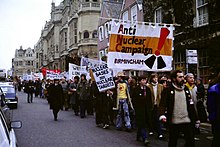
In order to increase awareness of all kinds of WMD, in 2004 the nuclear physicist and Nobel Peace Prize winner Joseph Rotblat inspired the creation of The WMD Awareness Programme to provide trustworthy and up to date information on WMD worldwide.
In 1998 University of New Mexico's Institute for Public Policy released their third report on U.S. perceptions – including the general public, politicians and scientists – of nuclear weapons since the breakup of the Soviet Union. Risks of nuclear conflict, proliferation, and terrorism were seen as substantial.
While maintenance of the U.S. nuclear arsenal was considered above average in importance, there was widespread support for a reduction in the stockpile, and very little support for developing and testing new nuclear weapons.
Also in 1998, but after the UNM survey was conducted, nuclear weapons became an issue in India's election of March,[citation needed] in relation to political tensions with neighboring Pakistan. Prior to the election the Bharatiya Janata Party (BJP) announced it would "declare India a nuclear weapon state" after coming to power.
BJP won the elections, and on 14 May, three days after India tested nuclear weapons for the second time, a public opinion poll reported that a majority of Indians favored the country's nuclear build-up.[citation needed]
On 15 April 2004, the Program on International Policy Attitudes (PIPA) reported that U.S. citizens showed high levels of concern regarding WMD, and that preventing the spread of nuclear weapons should be "a very important U.S. foreign policy goal", accomplished through multilateral arms control rather than the use of military threats.
A majority also believed the United States should be more forthcoming with its biological research and its Nuclear Non-Proliferation Treaty commitment of nuclear arms reduction.
A Russian opinion poll conducted on 5 August 2005 indicated half the population believes new nuclear powers have the right to possess nuclear weapons. 39% believes the Russian stockpile should be reduced, though not fully eliminated.
In popular culture
Weapons of mass destruction and their related impacts have been a mainstay of popular culture since the beginning of the Cold War, as both political commentary and humorous outlet. The actual phrase "weapons of mass destruction" has been used similarly and as a way to characterise any powerful force or product since the Iraqi weapons crisis in the lead up to the Coalition invasion of Iraq in 2003. Science-fiction may introduce novel weapons of mass destruction with much greater yields or impact than anything in reality.
Common hazard symbols
| Symbol Type (Toxic, Radioactive or Biohazard) | Symbol | Unicode | Image |
|---|---|---|---|
| Toxic symbol | ☠ | U+2620 | 
|
| Radioactive symbol | ☢ | U+2622 | 
|
| Biohazard symbol | ☣ | U+2623 | 
|
Radioactive weaponry or hazard symbol

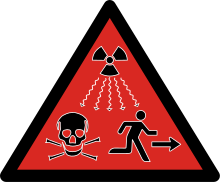
The international radioactivity symbol (also known as trefoil) first appeared in 1946, at the University of California, Berkeley Radiation Laboratory. At the time, it was rendered as magenta, and was set on a blue background.
It is drawn with a central circle of radius R, the blades having an internal radius of 1.5R and an external radius of 5R, and separated from each other by 60°. It is meant to represent a radiating atom.
The International Atomic Energy Agency found that the trefoil radiation symbol is unintuitive and can be variously interpreted by those uneducated in its meaning; therefore, its role as a hazard warning was compromised as it did not clearly indicate "danger" to many non-Westerners and children who encountered it. As a result of research, a new radiation hazard symbol (ISO 21482) was developed in 2007 to be placed near the most dangerous parts of radiation sources featuring a skull, someone running away, and using a red rather than yellow background.
The red background is intended to convey urgent danger, and the sign is intended to be used on equipment where very strong ionizing radiation can be encountered if the device is dismantled or otherwise tampered with. The intended use of the sign is not in a place where the normal user will see it, but in a place where it will be seen by someone who has started to dismantle a radiation-emitting device or equipment. The aim of the sign is to warn people such as scrap metal workers to stop work and leave the area.
Biological weaponry or hazard symbol

Developed by Dow Chemical company in the 1960s for their containment products.
According to Charles Dullin, an environmental-health engineer who contributed to its development:
"We wanted something that was memorable but meaningless, so we could educate people as to what it means."

